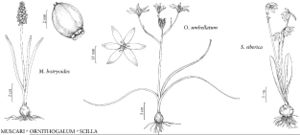Muscari
Gard. Dict. Abr. ed. 4, vol. 2. 1754.
| Taxon | Illustrator ⠉ | |
|---|---|---|
 | Muscari botryoides Ornithogalum umbellatum Scilla siberica | Yevonn Wilson-Ramsey Yevonn Wilson-Ramsey Yevonn Wilson-Ramsey |
Herbs perennial, scapose, from brown, tunicate, ovoid bulbs, with or without offsets (bulblets). Leaves (1–) 2–7, basal; blade linear, sometimes sulcate, glabrous, rather fleshy. Scape terete. Inflorescences terminally racemose, many-flowered, dense, bracteate, usually elongating in fruit; distal flowers smaller, sterile, differing in color, forming a tuft (coma); bracts minute. Flowers fragrant; perianth tubular to urceolate, usually constricted basally; tepals 6, connate most of their length, distal portions distinct, reflexed, short, toothlike; stamens 6, epitepalous, in 2 rows, included; anthers dark blue, dorsifixed, globose; ovary superior, green, 3-locular, inner sepal nectaries present; style 1; stigma 3-lobed. Fruits capsular, obtusely 3-angled, papery, dehiscence loculicidal. Seeds 6, black, globose, wrinkled to reticulate. x = 9.
Distribution
Introduced; temperate Europe, n Africa, sw Asia, expected elsewhere
Discussion
Species ca. 30 (3 in the flora).
Various species and cultivated forms of Muscari are commonly grown for their early spring flowers. They may reseed in the flora area, but they are mostly transported in soil containing the bulblets.
Muscari armeniacum Baker has been attributed to the flora, but no definite records of naturalized plants have been found. Herbarium specimens of that species are difficult to distinguish from those of M. neglectum, but live specimens of M. armeniacum have much paler blue flowers (A. Huxley et al. 1992).
Selected References
None.
Lower Taxa
Key
| 1 | Tepals of fertile flowers pale to olive brown, sterile flowers bright violet, shorter than the 6–25 mm ascending pedicels. | Muscari comosum |
| 1 | Tepals of fertile and sterile flowers blue, longer than the 1–4(–5) mm declined, nodding, or spreading pedicels. | > 2 |
| 2 | Racemes 12–20-flowered; leaf blades 3–8 mm wide; perianth tubes of fertile flowers globose, sky blue. | Muscari botryoides |
| 2 | Racemes 20–40-flowered; leaf blades 2–4(–5) mm; perianth tubes of fertile flowers obovoid to oblong-urceolate or cylindric, blackish blue. | Muscari neglectum |
"broad" is not a number."elongating" is not a number."thicker" is not a number.